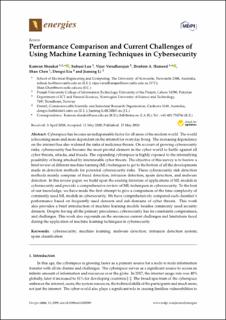| dc.contributor.author | Shaukat, Kamran | |
| dc.contributor.author | Luo, Suhuai | |
| dc.contributor.author | Varadharajan, Vijay | |
| dc.contributor.author | Hameed, Ibrahim A. | |
| dc.contributor.author | Chen, Shan | |
| dc.contributor.author | Liu, Dongxi | |
| dc.contributor.author | Li, Jiaming | |
| dc.date.accessioned | 2020-05-20T12:45:32Z | |
| dc.date.available | 2020-05-20T12:45:32Z | |
| dc.date.created | 2020-05-19T14:40:58Z | |
| dc.date.issued | 2020 | |
| dc.identifier.citation | Energies. 2020, 13 (10), . | en_US |
| dc.identifier.issn | 1996-1073 | |
| dc.identifier.uri | https://hdl.handle.net/11250/2655199 | |
| dc.description.abstract | Cyberspace has become an indispensable factor for all areas of the modern world. The world is becoming more and more dependent on the internet for everyday living. The increasing dependency on the internet has also widened the risks of malicious threats. On account of growing cybersecurity risks, cybersecurity has become the most pivotal element in the cyber world to battle against all cyber threats, attacks, and frauds. The expanding cyberspace is highly exposed to the intensifying possibility of being attacked by interminable cyber threats. The objective of this survey is to bestow a brief review of different machine learning (ML) techniques to get to the bottom of all the developments made in detection methods for potential cybersecurity risks. These cybersecurity risk detection methods mainly comprise of fraud detection, intrusion detection, spam detection, and malware detection. In this review paper, we build upon the existing literature of applications of ML models in cybersecurity and provide a comprehensive review of ML techniques in cybersecurity. To the best of our knowledge, we have made the first attempt to give a comparison of the time complexity of commonly used ML models in cybersecurity. We have comprehensively compared each classifier’s performance based on frequently used datasets and sub-domains of cyber threats. This work also provides a brief introduction of machine learning models besides commonly used security datasets. Despite having all the primary precedence, cybersecurity has its constraints compromises, and challenges. This work also expounds on the enormous current challenges and limitations faced during the application of machine learning techniques in cybersecurity. | en_US |
| dc.language.iso | eng | en_US |
| dc.publisher | MDPI | en_US |
| dc.rights | Navngivelse 4.0 Internasjonal | * |
| dc.rights.uri | http://creativecommons.org/licenses/by/4.0/deed.no | * |
| dc.title | Performance Comparison and Current Challenges of Using Machine Learning Techniques in Cybersecurity | en_US |
| dc.type | Peer reviewed | en_US |
| dc.type | Journal article | en_US |
| dc.description.version | publishedVersion | en_US |
| dc.source.pagenumber | 27 | en_US |
| dc.source.volume | 13 | en_US |
| dc.source.journal | Energies | en_US |
| dc.source.issue | 10 | en_US |
| dc.identifier.doi | https://doi.org/10.3390/en13102509 | |
| dc.identifier.cristin | 1811722 | |
| dc.description.localcode | © 2020 by the authors. Licensee MDPI, Basel, Switzerland. This article is an open access article distributed under the terms and conditions of the Creative Commons Attribution (CC BY) license (http://creativecommons.org/licenses/by/4.0/). | en_US |
| cristin.ispublished | true | |
| cristin.fulltext | original | |
| cristin.qualitycode | 1 | |

